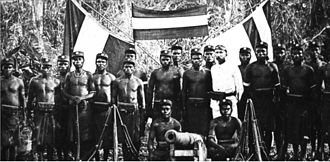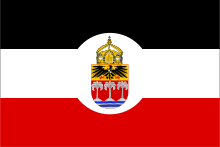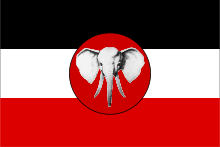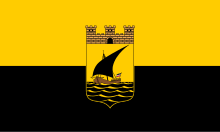Flags in the colonies of the German Empire

The flags in the colonies of the German Empire were the flags used in the German colonies from 1884 . They were no longer used after the outbreak of World War I and the gradual occupation of the colonies by Allied forces. Special flags for the colonies were not introduced until 1891 and 1893, respectively. Occasionally published imperial flags with additional colonial coats of arms are merely drafts that were made in 1914, but were never officially used. In the German colonies there was also a certain spread of flags of private colonial and similar companies.
Acquisition of colonies
Due to the economic upswing in Germany in the 1880s, colonial policy was pursued with vigor. Although Chancellor Bismarck was originally against Germany's colonial aspirations - he feared conflicts with other major European powers - the foreign policy situation seemed to have stabilized from 1884. In rapid succession, some areas in Africa and Oceania were therefore made colonies, which were officially designated as "protected areas". Essentially these were:
- German South West Africa on April 24, 1884
- Togo on July 5, 1884
- Cameroon on July 12, 1884
- German New Guinea on November 4, 1884
- German East Africa on December 4, 1884
- Witu on May 27, 1885
- Samoa on February 17, 1900
- In 1898 the area of Kiautschou with its capital Tsingtau was leased from the Chinese Empire to the German Empire.
- In 1899, island groups of Micronesia were acquired by Spain.
- In 1911 New Cameroon was ceded by France.
Flags in the early years
In contrast to the other European colonial powers such as B. Great Britain , the German Empire initially showed no particular interest in the design of special flags for the various colonies. The official occupation of the area was usually sealed by the flag being raised in the imperial war flag . Examples of such flag hoists are known from Angra Pequena (German South West Africa) on August 7, 1884, from Cameroon on July 21, 1884 or from Mioko (New Guinea) on November 4, 1884. The national and commercial flags, which could also be used by private parties, were shown. The war flag and the national flag were the flags exclusively used in the early years to represent the German Empire. Postal flags, which were used in the colonies to mark postal stations, were an exception. Ships carrying Imperial Post also carried the post flag, to which a yellow post horn was added based on the war flag.
Flags from 1891

The first special colonial flag in the strict sense of the word was created for the governor of German East Africa: On March 5, 1891, the Supreme Order stipulated that a separate command signal should be introduced for the governor . The imperial eagle was placed on the white stripe of the national flag without a crown or chain. This command signal was not allowed to be used on land, but only on ships of the governor or the Imperial Navy . If the flag was used in a boat, it had to be attached to the bow.
At the end of 1892, Kaiser Wilhelm II decided to modify the entire flag system of the Empire. In the course of this, special flags were created for the colonies for the first time.
After April 1, 1893, special service flags were used in the "protected areas". Showing or hoisting the Reich war flag was prohibited. The then governor of German East Africa, Baron von Soden , however, received special permission from the emperor to continue to display the imperial war flag.
On April 1, 1893, the Foreign Office received its own service flag, in the center of which was a white, enlarged disc on which the imperial eagle had been placed. This flag was henceforth used by all governors and official bodies in the colonies. The only exceptions were the aforementioned German East Africa and official offices of the Kiautschou lease area. Since this area was not a colony in the narrower sense and was therefore subordinate to the Reichsmarineamt , all official bodies showed the Reich war flag here from 1898 onwards. Starting in 1898, all civil institutions, lighthouses and other institutions there used the service flag of the Imperial Navy, which was created on April 1, 1893 and which was also regarded as a kind of national flag in Kiautschou.
On August 13, 1893, separate additional emblems were introduced for the government vehicles and government buildings in the colonies for the areas of pilot management and customs . These were attached to the stick side of the Foreign Office flag in a black stripe. In the area of the pilot administration, these were the red letters “L” and “V”, between which there was a yellow, unclear anchor , while the customs authorities carried the same flag, but used a “Z” instead of the “L”.
Also from 1893 a redesigned imperial post flag was introduced in the colonies.
In the implementation regulations regarding the flying of the war flag on the part of the Schutztruppe for German East Africa of December 12, 1893 it says:
"With reference to the Highest Order of August 21, 1893 - Marine Ordinance Gazette page 223 - the use of the German war flag by the authorities and institutions of the Imperial Protection Force for German East Africa, the following implementing provisions come into force:
- The war flag will be used until further notice
A. In the coastal places:
- On all fortifications as far as they are occupied by the protection force.
- On the barracks inhabited by the protection force.
- On the command building of the security forces authority in Dar-es-Salaam .
B. Inside:
On all stations that are occupied by a division of the protection force under the leadership of a German officer or NCO. "
This special permit only expired on November 9, 1904.
On March 1, 1898, the governor of Kiautschou was also approved to fly the same flag as the governor of German East Africa. It is not known why special governor flags were created in these two cases. In the Supreme Order of March 1, 1898 it says:
“The governor wears a flag like that of the governor of East Africa as a badge of command and distinction within his service area. The provisions enacted for the latter in the flag and salute regulations apply to the governor's flag in the Kiautschau area with the exception that for the latter, as well as for the person of the governor, thirteen shots are responsible as salutes, unless a higher one due to personal rank Salute is prescribed. "
When a special authority was created for the colonies with the Reichskolonialamt on May 17, 1907 , the question arose as to which flag this authority should represent. The choice fell on the flag of the Foreign Office, which was confirmed by the Supreme Order of October 9, 1907.
- Permit to fly the German flag
As a rule, the native population of the colonies was granted the right to use the national flag of the empire on their boats. Upon request, the respective boat owners received a permit to fly the German flag :
- In German East Africa these permits were issued from July 28, 1891 and
- issued on the Marshall Islands from September 19, 1893.
- It is also known that from February 8, 1909, the use of the German flag on Lake Victoria and Lake Nyassa in East Africa became possible.
| flag | Period of use | designation | Remarks |
|---|---|---|---|
 |
1892-1902 | Reich war flag | Shown in German East Africa and by official bodies in Kiautschou. |
 |
From 1903 | Reich war flag | The last version of the war flag was used in German East Africa until 1904 and also by official bodies in Kiautschou. |
 |
From 1891/1898 | Governor flag for German East Africa and Kiautschou | Used in German East Africa from 1891 and in Kiautschou from 1898. |
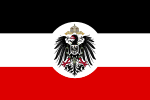 |
From 1893 | Official flag of the Foreign Office / Reich Colonial Office | The Foreign Office was responsible for the colonies until 1907, after which the newly created Reich Colonial Office took over. |
 |
From 1893 | Service flag in the area of pilot management | Construction details for the pilot flag: 
|
 |
From 1893 | Service flag in the area of customs administration | Construction of the emblem like pilot flag, but with stylistically adapted letter "Z" |
 |
From 1898 | Imperial service flag of the Imperial Navy | Was used as the flag of all civil institutions in Kiautschou. Lighthouses were also equipped with it. |
 |
From 1893 | Service flag in the area of the Reich Post Office | Was used to mark post stations and post ships |
Local flags
In some places local flags were used in addition to or instead of the German flags:
Flag of the Basterland
The Basters living in the area of the German South West Africa colony apparently displayed their own flag. This was square in shape and consisted of three concentric stripes in black, red and white.
Flag of the Ralik Islands
The Ralik Islands are part of the Marshall Islands archipelago . The western 18 atolls are called Ralik, which can be translated as "sunset". The actual colonization of the islands by the German Empire did not officially begin until October 15, 1885, but in November 1878 a German cruiser corvette , the SMS Ariadne , reached the atolls in search of a coal station. On November 19, 1878 , the captain of Ariadne, Bartholomäus von Werner , concluded a contract with the chief chiefs about the coal station on the Jaluit- Atoll belonging to the archipelago . Article VII of this treaty described a flag that the captain presented to the chiefs on the last day of their stay. It was supposed to symbolize the German Empire and was similar to the national flag, but was provided with two additional stripes, one white and one black. The flag was well received by the locals and became more popular in the years that followed. The port of Jaluit was approached by 67 ships in 1883, 11 of which sailed in and out under the Ralik flag. As mentioned, the German Reich took possession of it officially in October 1885 when the Reich flag was raised. It was only in 1893 that the German Reich Commissioner for the Protected Area of the Marshall Islands noticed that the locals were flying an unusual flag. On May 12, 1893, he wrote to the Reich Ministry of the Interior:
“With the present I would like to draw your Excellency's attention to a fact which, as far as I have been able to ascertain, has so far been ignored and unmentioned.
Several of the local chiefs have their own small vehicles with which they transport people between the individual islands and load copra back and forth. The chiefs of the island of Arno are now even thinking of buying a larger ship at a price of M30,000, intended exclusively for the copra trade.
According to their character, all of these vehicles could very well be affected by the Prussian. Ordinance on the Registration of Seagoing Ships (February 27, 1862) enacted exceptions to be applied, ie these ships could also be allowed to fly the German flag of war without prior entry in a ship register and issuing a certificate.
So far, all of these vehicles, six in number, of which 3 measure over 50 cbm, 2 over 100 cbm gross volume, have a fantasy flag, here called Marshal flag, black, white, red, white, black, which the chiefs once used in times long past someone has loaned.
Although it cannot be remotely asserted that the expression of any striving for independence is hidden in this flag, the reputation of the German protectorate and the awareness of the natives that they are now German should only be strengthened if they do so also confirmed by their own ships the German flag would be shown ... "
The official activities set in motion with this letter initially led on September 19, 1893 to the fact that the locals were given permission to fly the German Reich flag. In order to counteract any separatist efforts of the island population, one year later, on March 7, 1894, the use of the Ralik flag was banned.
Flag of the Sultanate of Witu
The territory of the Sultan of Witu was placed under German protection in 1885 at the request of the Sultan Ahmad Simba al-Nabahani and through the mediation of the Denhardt brothers . The local flag was carried on by the sultan. According to the explorer Alfred Voeltzkow, it was vertically divided into two fields. The field on the flagpole was white, the outer one red, with a white star. With the so-called Helgoland-Zanzibar Treaty in 1890, the German Empire broke off the protective relationship with the Sultanate of Witu in favor of Great Britain. The later British protectorate flag had the Union Jack in a red border.
Special flags in the Kiautschou lease area
From 1913, special flags were introduced for the local junks in the port of Tsingtau . Junks were classified according to size. Thus, larger, seaworthy junks were divided into classes I or II and smaller, only locally deployed junks into class III. Each junk was marked with a number and this was shown on a flag. Class I or II junks were given a white number on a red flag, while those of class III had red numbers on a white flag. Furthermore, a distinction was made between whether the junks entered the port to unload the cargo (clearing in) or left the port (clearing out). For this, additional pennants were attached below the number flag, which should make this state visible. For “clearing in” it was a blue-red, striated pennant with the white letter “E”, while “clearing out” was marked with a blue-white pennant and the red letter “A”.
Weather flags
From 1913 onwards, the weather situation was indicated by special weather flags that were placed on the Tsingtau observatory . In detail these were:
- For "cheerful" a white flag,
- for "cloudy" a green flag,
- a blue flag for "rain",
- for "stormy" a red flag as well
- for "uncertain weather" a blue-white-blue-white striped flag.
Troop flag
In contrast to the military units in the colonies, the troops in the Kiautschou leased area carried a troop flag. The III stationed there. Sea battalion burned the flag after the capitulation on November 7th, 1914. The top of the flag (possibly the flagstick) was then flown out by Gunther Plüschow . Since the Second World War , the top and the flagstick have been considered lost.
Flags of colonial companies, shipping companies, railway companies
The colonial societies were usually societies for the operation of various economic enterprises in colonies, which were mostly organized as private corporations. In the future, trade and economy should be set in motion by German settlers. The societies generally used flags that were composed of the national colors of the German Empire, black, white and red . Due to the structure of the companies under private law, little is known about flag details such as the date of introduction, exact dimensions or use. However, the flags of the societies were apparently shown widespread in the colonies.
The German-East African Society was founded on September 7, 1885 and initially used a flag on which a palm tree, a lion and the Southern Cross were depicted on a red, central background . A black bar cross was depicted in each of the four corners of the flag . Probably around 1892 the society adopted a new flag, which showed a black cross on a white cloth. In the upper left corner was the Southern Cross on a red field. This flag became one of the most famous symbols of neo-colonial movements in Germany after the loss of the colonies. After one of the founders of the company, it was also known as the " St. Peter's Flag ".
A German-West African society , which was founded on November 20, 1896 in Hamburg, used a red, black-bordered cross on a white background. In the center of the flag was a black, stylized eagle on a gold-colored, oval field. The first letters of the company were found in the four corners of the flag.
The flag of the German New Guinea Compagnie , which became active from 1884, showed the imperial colors on a white field in the upper left corner, while at the flying end of the flag a black, heraldic lion held a red Bourbon lily in its claws.
The German trading and plantation company of the South Sea Islands in Hamburg was founded on March 16, 1878. This used a black-white-red diagonally split flag with the company's initials in a white stripe. From this company and the company Hernsheim & Co, which used a red flag with their initials, the Jaluit company emerged on December 21, 1887 . Initially also equipped with a red flag and white initials, the company changed the flag a short time later, in which a black-white-red circle was seen in the center, which was apparently supposed to symbolize the globe.
The East African Railway Company , which was founded in Berlin on June 29, 1904 , carried a black, white and red diagonally quartered flag on which a winged track bike and the company's initials were located in a circular center.
Planned flags for the colonies
In 1912 and 1913, the State Secretary in the Reich Colonial Office, Wilhelm Solf , made a trip through Africa. Among other things, he also visited some British colonies. He noticed that the British had created their own emblems for their colonies. When Solf returned to Germany, he gave a lecture to Kaiser Wilhelm II in which he described the advantages of these coats of arms. In particular, he emphasized the positive impression that the various national emblems had on the local population. The emperor was impressed and commissioned Solf to draft coats of arms for the German colonies. Solf carried out this task in cooperation with the herald's office and Duke Johann Albrecht von Mecklenburg . Solf and Duke Albrecht carried out intensive research and studied the history of the countries for which coats of arms were to be created. So they chose heraldic symbols that were characteristic of the respective areas. In 1914 six coats of arms were presented to the emperor, some of which he corrected and then approved. However, the outbreak of World War I prevented their introduction and the coats of arms were forgotten. It is also known that separate flags were planned for the colonies. The only known source for this was for a long time from 1933. On February 1, 1933, an article appeared in the Afrika-Nachrichten (Illustrierte Kolonial- und Auslandszeitung), which went into detail about the planned coats of arms and flags. From the article of the Afrika-Nachrichten it emerged that the coat of arms on the flags should be shown without the imperial crown and imperial eagle:
"The flags envisaged for the various protected areas were the black-white-red imperial flag with the emblems of the coat of arms of the present designs, omitting the imperial crown and the imperial eagle."
The coats of arms were not shown in color in the Afrika-Nachrichten . Colored images of the coats of arms did not appear on neo-colonial postcards until the 1930s and on the German colonial calendar in 1940 . Flag reconstructions based on this adhered to the description in the Afrika-Nachrichten , but were purely speculative in nature. The original drafts and documents for the approval of the coat of arms and the flag design were considered lost.
In 2010, the original designs were finally found in Wilhelm Solf's estate, and it turned out that he had developed a total of seven, and after new publications eight different design patterns for the flags. It turned out that the previous attempts at reconstruction did not correspond to the original drafts. In particular, occasionally published reconstructions of the flags that show the coat of arms with an additional lettering band (with the name of the colony) were never planned. Such coats of arms were not printed until the 1930s in various, predominantly neo-colonial publications. On February 14, 1914, Solf submitted the first three drafts. Four more followed around mid-1914. All designs used the national flag of the empire in black, white and red as the basis. In detail, Solf considered the following variants:
- The complete coat of arms in the center of the white stripe and the colonial symbol in the upper left corner on a colored background
- The complete coat of arms in the center on an enlarged white circular disk
- The complete coat of arms, but without the crown, lying in the center on an enlarged white circular disc
- In the center, on an enlarged white circular disc, the imperial crown with ribbons, and in the upper left corner the colonial symbol under the imperial eagle lying on a colored background
- The colonial symbol lies in the center on a colored, enlarged circular disc
- The colonial symbol lies in the center on a colored heraldic shield, with the shield clearly reaching into the black or red stripe
- The coat of arms without the imperial crown in the center, clearly reaching into the black or red stripes
According to Karaschewski (2011) there was an eighth variant: 8. The colonial symbol in the top left corner on a colored background (without an additional coat of arms in the center)
The documents found in Wilhelm Solf's estate do not reveal whether one of these drafts was shortlisted in 1914. On December 14, 1932, however, Solf wrote to the editor of the Afrika-Nachrichten :
“One must also speak of flags, and perhaps add the sentence that the coats of arms you have described should be placed in the middle of the white field of the old black-white-red flag, without which is on each one Coat of arms repeating imperial eagle and imperial crown. "
It is not clear from the correspondence whether the coats of arms should extend into the black or red stripes - as in draft no. 6 shown here.
Description of the planned colonial coat of arms
The imperial eagle on a golden background and the imperial crown should be placed on all heraldic shields. Later reconstructions, which showed a banner with the name of the respective colony instead of the imperial crown, came from - mostly neo-colonial - publications of the 1930s. In 1917 Wilhelm Solf tried to publish the coat of arms in the Hohenzollern yearbook, but this failed because of the high costs. On November 5, 1919, the Reich Chancellery decided that the coats of arms should become the private property of Wilhelm Solf. Solf was then allowed to privately print and publish the coat of arms, omitting the imperial crown, but this only happened in the Africa News in 1933 . There, however, the coats of arms were shown in the originally planned version, i.e. with the imperial crown, not colored.
| coat of arms | date | area | Description of the heraldic shields |
|---|---|---|---|
 |
1914 | German East Africa | Reason: light vermilion; Lion head: silver with bright or greenish lights |
 |
1914 | German Cameroon | Reason: vermilion; Elephant head: silver with bright or greenish lights |
 |
1914 | Togoland | Reason: silver; Palm: dark green with bright lights; Snakes: gray with green lights and brownish shades |
 |
1914 | German South West Africa | Reason: navy blue; Ox head: silver with bright or greenish lights; Diamond: white with yellowish highlights |
 |
1914 | German Samoa | Reason: light vermilion; Palm trees: silver; Coconuts: gold; Soil: silver; Waves: blue |
 |
1914 | German New Guinea | Reason: green; Bird of Paradise Feathers: Gold; Decorative feathers, head and claws: black-blue |
Planned flag for Tanga (German East Africa)
It is known that a coat of arms and a flag were also planned for the city of Tanga in German East Africa. After Tanga had been granted city rights on April 1, 1914, the city council decided to adopt a coat of arms, a flag and an official seal. The coat of arms should show a sailing boat ( dhow ) floating on the waves on a golden background . The coat of arms was crowned by a wall crown. The official request by the then governor of German East Africa, Heinrich Schnee , was made on June 7, 1914 in Berlin. The Herald's Office checked the coat of arms and requested three corrections. On the one hand, the top of the wall should be stylistically changed and the hull should be given a uniform color. The original design provided for a striped hull in the colors (from above) brown, white and light blue. In addition, the national flag at the rear should be made smaller overall. The planned city flag should show the corrected coat of arms on a gold and black background. Since this municipal flag was apparently the first application of its kind in the colonies, the question of which group of people had the right to approve the acceptance of coats of arms and flags had to be clarified. The competent Reich Colonial Office decided that the respective governors were generally allowed to accept such flags and coats of arms. However, a prior check by the Herald's Office should take place. The outbreak of the First World War stopped the further development of the coat of arms and flag. From the documents of the Reich Colonial Office of June 22, 1916 it emerges that the plans for the adoption of the communal symbols of Tanga are to be regarded as "finished", since German East Africa has in the meantime been lost to the Allied forces. The symbols in Tanga were therefore no longer used.
Web links
- Colonial flags
- Flag use in German colonies (PDF; 8.5 MB, English)
- Flags of the World - Former Colonies and other Overseas Territories (Germany )
swell
- Jörg M. Karaschewski: Flags in the German Protected Areas , German Society for Flag Studies, 2005, ISBN 978-3-935131-04-9
- Jörg M. Karaschewski: Flags in the German Empire , Books on demand GmbH, 2008, ISBN 3-9351-3104-6
- Jörg M. Karaschewski: Coats of arms and flags of the German colonies , Wolfenbüttel 2011, ISBN 978-3-942562-51-5
- Hormann / Plaschke: German flags , Edition Maritim GmbH, Hamburg 2006, ISBN 3-89225-555-5
- Andreas Herzfeld: Flag Use in German Colonies , lecture at the 21st International Congress of Vexillology , Buenos Aires, 2005
- Rüdiger F. Dreyhaupt: German National Flags Part III: North German Confederation and German Reich until 1918 , in: Der Flaggenkurier No. 9/1999, German Flagship Society, Berlin
Individual evidence
- ↑ Flag of the Basterland on FOTW
- ↑ http://www.karaschewski.de/kolonialflaggen/Kiautschou/Fahne%203%20seebataillon.jpg ( Memento from December 10, 2006 in the Internet Archive )
- ↑ Jörg M. Karaschewski : Coats of arms and flags of the German colonies , 2011, p. 21
- ↑ Andreas Herzfeld: The coat of arms and flag designs for the German colonies , in: Der Flaggenkurier No. 31, April 2010, German Society for Flagship
- ↑ Jörg M. Karaschewski: Coats of arms and flags of the German colonies , 2011, p. 24
- ↑ The beginnings of municipal flags and coats of arms in the German protected areas ( Memento from April 16, 2007 in the Internet Archive )





















